Learning Mandarin as a beginner can feel deceptively easy at first. With no verb conjugations, no plural forms, and no grammatical gender, the language seems refreshingly simple compared to many Indo-European languages. But as you progress beyond basic greetings and vocabulary, subtle grammatical challenges begin to appear—many of which don’t have direct parallels in English. These small but important points can confuse learners and lead to errors that may persist if not addressed early on.
In this article, we will navigate through three common grammar pitfalls for beginner Mandarin learners and break them down in a clear, easy-to-understand way:
- When to drop the structural particle 的
- Choosing between 呢 and 嗎 for questions
- Understanding the difference among 有 and 是 and 很+adj.
1. When Do We Drop “的”?
One of the first grammar particles beginners learn in Mandarin is 的 (de), a structural particle used to connect a modifier with a noun. It’s often compared to the possessive “’s” in English or the “of” construction.
Take the basic usage below for example:
- 我的朋友 (wǒ de péngyǒu) = my friend
- 好吃的菜 (hǎochī de cài) = delicious food
However, you might also have noticed that in many everyday conversations, native speakers seem to drop the 的 altogether:
- 我媽媽 (wǒ māma) instead of 我的媽媽
- 他朋友 (tā péngyǒu) instead of 他的朋友
So when is it okay to omit “的”?
You can often omit “的” when:
- The modifier is a pronoun, especially in casual speech.
e.g. 他的同事很熱情→他同事很熱情 = His colleague is very enthusiastic.
- You're referring to close relationships (mom, dad, friend, teacher, etc.).
e.g. 我的媽媽來了→我媽媽來了 = My mom is here.
- The modifier serves as a classification for the noun, allocating it into a certain genre or variation.
e.g. 舊的衣服→舊衣服 = old clothing
德國的車→德國車 = German cars

We canexplore this rule further by distinguishing the two examples below:小的狗 ≠ 小狗
小的狗 = a physically tiny dog
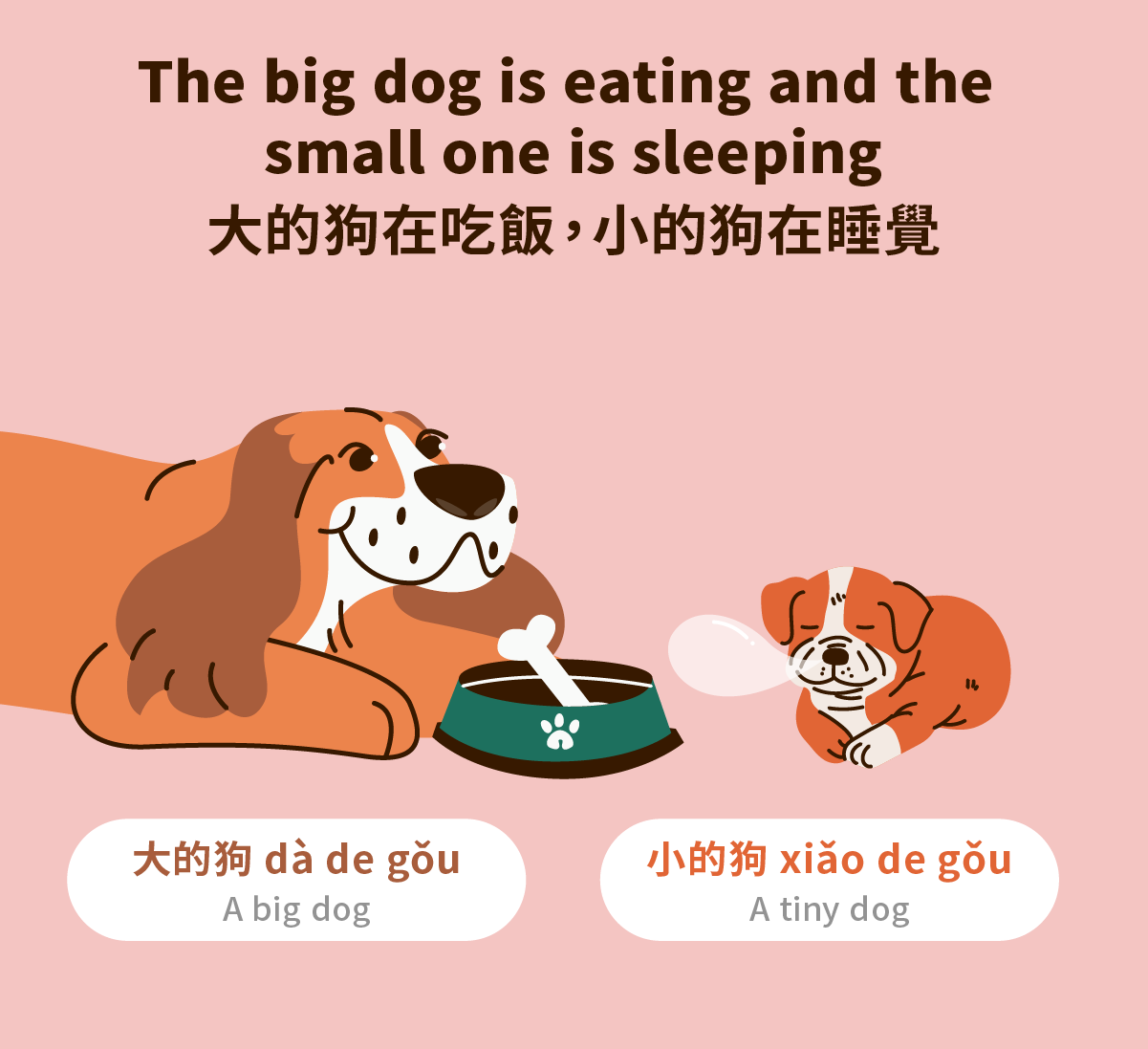
With 的 included, the modifier 小的 serves merely as a description, which suggests that the dog is physically small.
vs.
小狗 = puppy, a dog that’s young by age
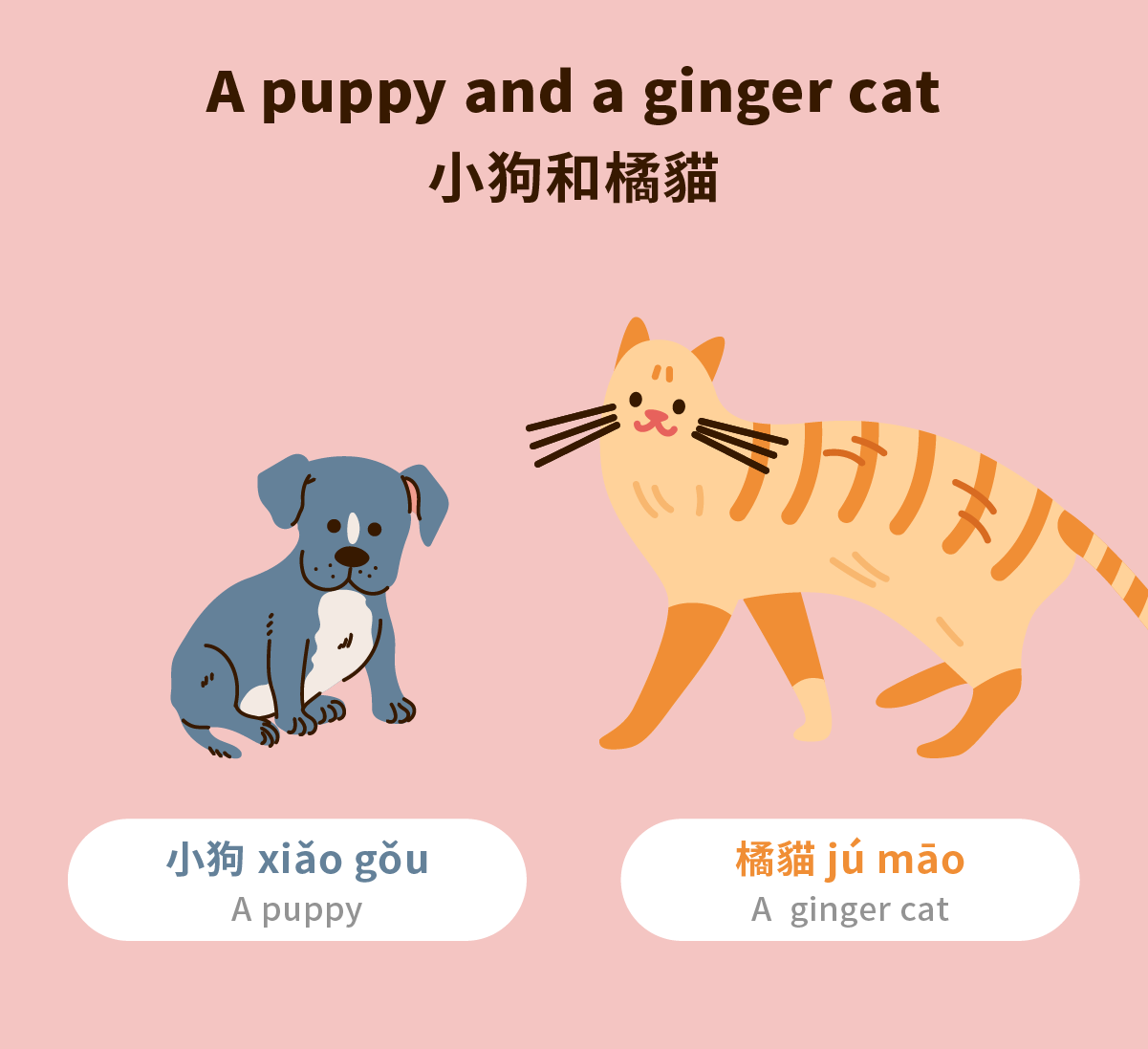
By omitting the 的, the modifier classifies the noun, making the word 小狗 a specific genre that implies the dog is young by age. Same for ginger cats (橘貓).
(Just like in casual English, people sometimes call mature dogs 小狗 /puppy if they are feeling affectionate. So don’t get confused when you see people refer to a mature Labrador as ‘小狗’.)
And When is it not okay to omit 的?
Ingeneral, 的 is required when:
- The modifier includes a verb, e.g. 他買的那本書 = the book he bought
- When there are multiple modifiers in a sentence, you must keep the 的 of the last modifier. For instance,
我家(的)二樓(的)最大的房間 → 我家二樓最大的房間
= The biggest room on the second floor of myhouse.
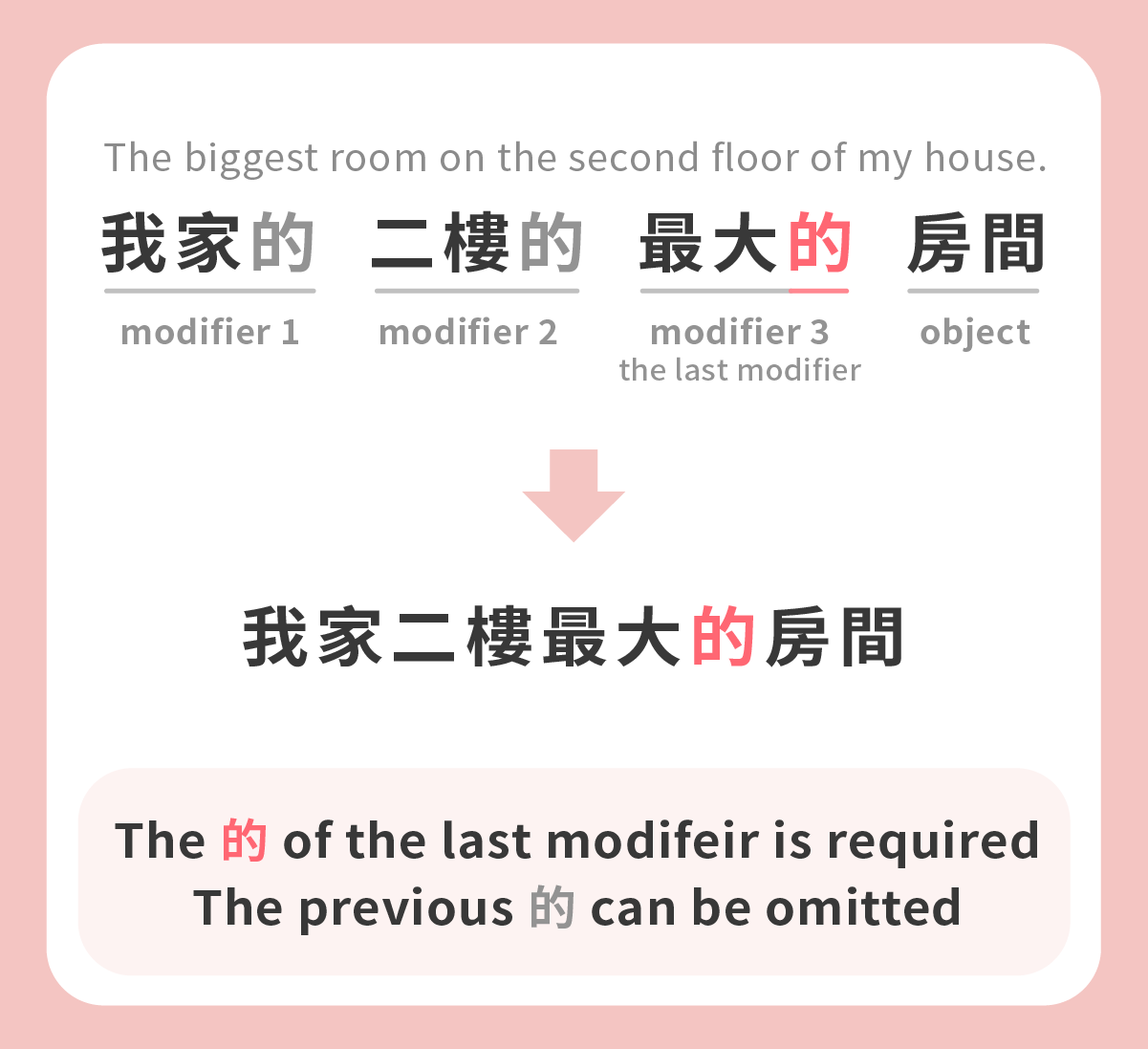
- You want to be precise or are writing formally.
Why does this matter? Dropping 的 can make your speech sound more natural and fluent, but overdoing it or using it inappropriately can create confusion. For instance, longer or unfamiliar modifiers should still include 的 to keep the meaning clear.
Quick tip: If you’re unsure, it’s safer to include 的. As you listen to more natural speech, you’ll get a better sense of when native speakers omit it.
2. “呢” vs. “嗎” – Asking the Right Kind of Question
Both 呢 (ne) and 嗎 (ma) are particles used in questions, but they serve different functions and are not interchangeable. This can be a bit confusing at first, but once you get the knack of it, it really is quite simple. Let’s break it down:
Use “嗎” for Yes/No Questions:
- 你是老師嗎?= Are you a teacher?
- 他喜歡咖啡嗎?= Does he like coffee?
And “呢” for Tag Questions, Follow-ups, and Open-ended Questions:
- Returning a question:
- 我很好,你呢? = I’m fine, and you?
- Topic continuation:
- Tom 在打遊戲,那你呢? = Tom is playing games. What about you?
- Open-ended question: 呢 can be used in open-ended questions to soften the tone and make you sound more amicable, but it is not necessary.
- 你最喜歡的食物是什麼(呢)?= What’s your favorite food?
- 你要去哪裡(呢)?= Where are you going?
In short, before forming a question, ask yourself what kinds of answers are you expecting?
If there’s only 2 possible answers, either ‘Yes’ or ‘No’ → use 嗎
If there can be more than 2 kinds of answers→ use 呢
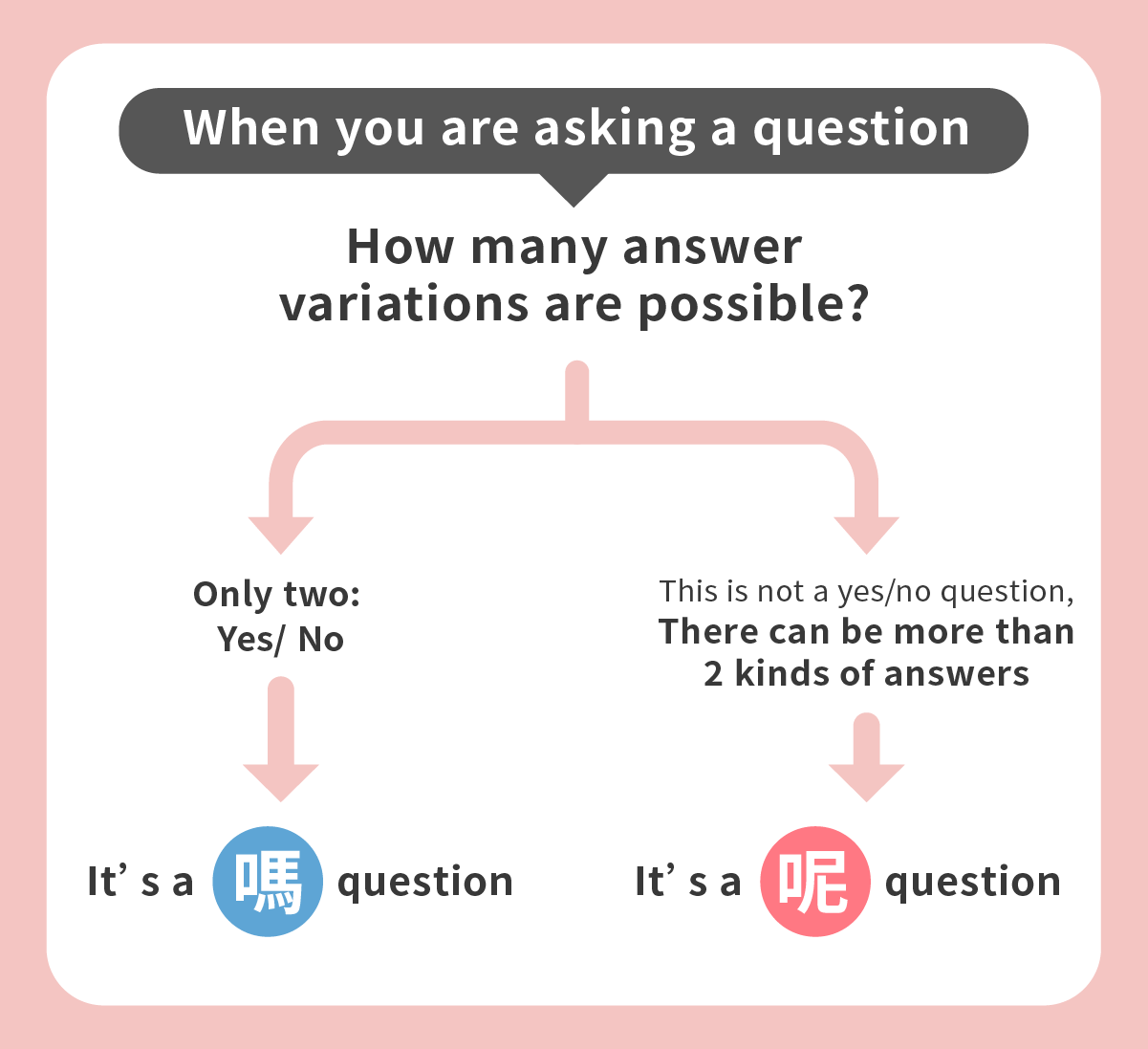
Common mistakes:
1.Combining both 呢 and 嗎 in one question:
- ❌ 你是學生嗎呢?
- ✅ 你是學生嗎? or 你呢?
2.Using 嗎 with question words like “what,” “where,” “who,” etc.
- Incorrect: 你是誰嗎? ❌
- Correct: 你是誰(呢)? = Who are you? ✅
These question words imply that there can be numerous kinds of answers, which contradicts with the ‘yes/no’ rule of 嗎. So if there is a question word in your sentence, you can either
A) not use any particles at the end of the sentence
or
B) use 呢 to add a friendly touch.
Quick wrap-up: Use 嗎 when you want a straightforward yes/no answer. Use 呢 when continuing a topic, asking a follow-up, or referring back to someone else’s response.
3. “有” vs. “是” – Two Very Different Verbs
In English, “to be” is used in many situations: identity, existence, possession. But in Mandarin, these functions are split between different words—particularly 是 (shì) and 有 (yǒu).
“是” = to be (identification)
- 他是老師 = He is a teacher.
- Amy 是美國人= Amy is an American.
“有” = there is/are ; to have (existence and possession)
- 桌子上有一本書 = There is a book on the table (existence)
- 我有一本書 = I have a book (possession)
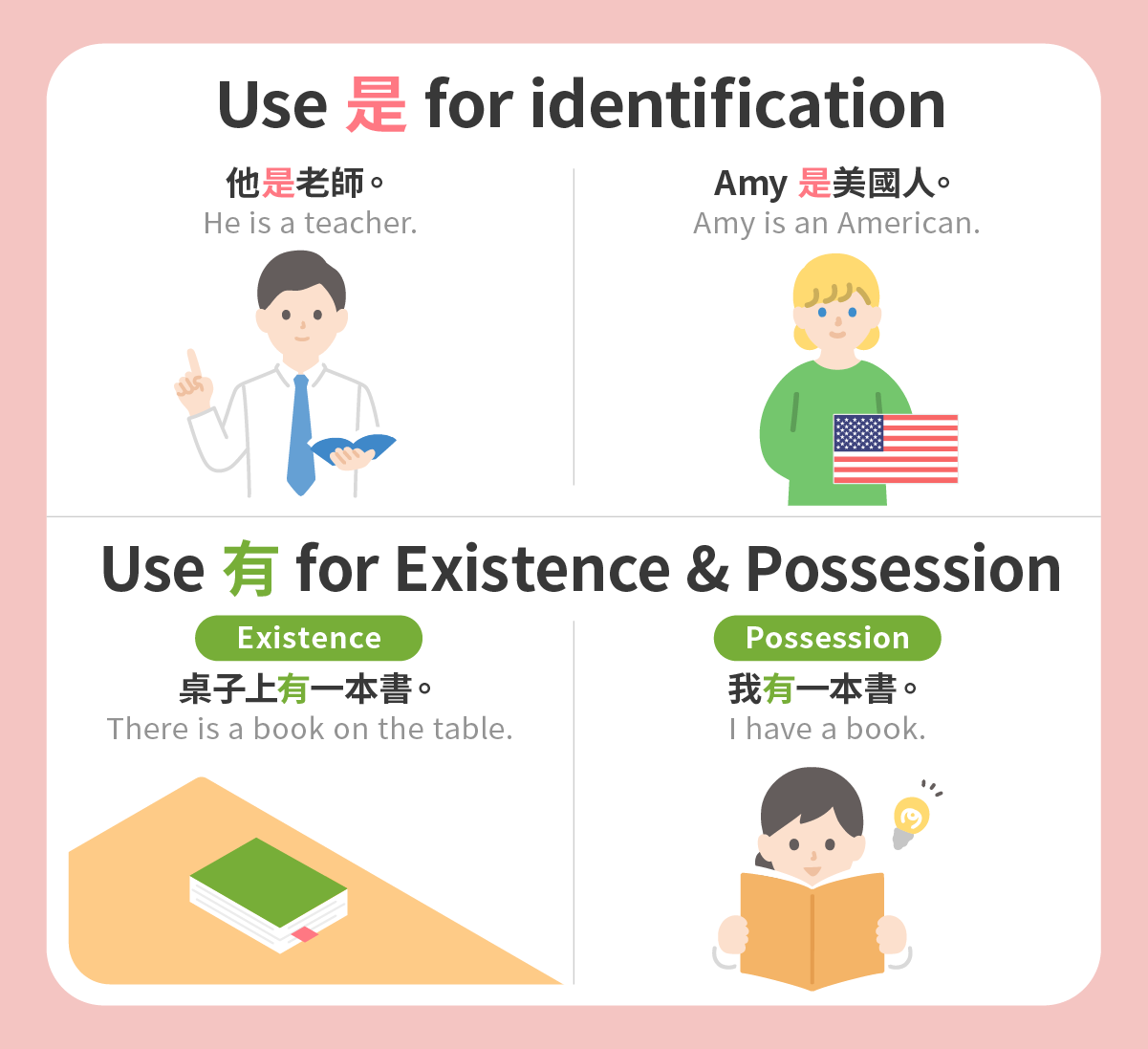
Where confusion arises:
In English, “There is a book on the table” uses “is,” so learners might try to use 是:
- ❌ 桌子上是一本書
- ✅ 桌子上有一本書
Another common mistake:
- ❌ 他有學生 (He has student) — when the learner means “He is a student”
- ✅ 他是學生
And:
- ❌ 他是很多錢 = He is a lot of money (makes no sense)
- ✅ 他有很多錢 = He has a lot of money
Summary tip: Think of 是 as an equal sign, and 有 as the word “have” or “there is.”
4. “是” Sentences vs. “很 + Adjective” Sentences
Following Pitfall 3, another subtle but common issue for Mandarin beginners is confusing 是 sentences with descriptive ones that use adjectives.
In English, we say “He is tall” or “She is pretty,” using the verb “to be.” In Mandarin, we do not use 是 before adjectives.
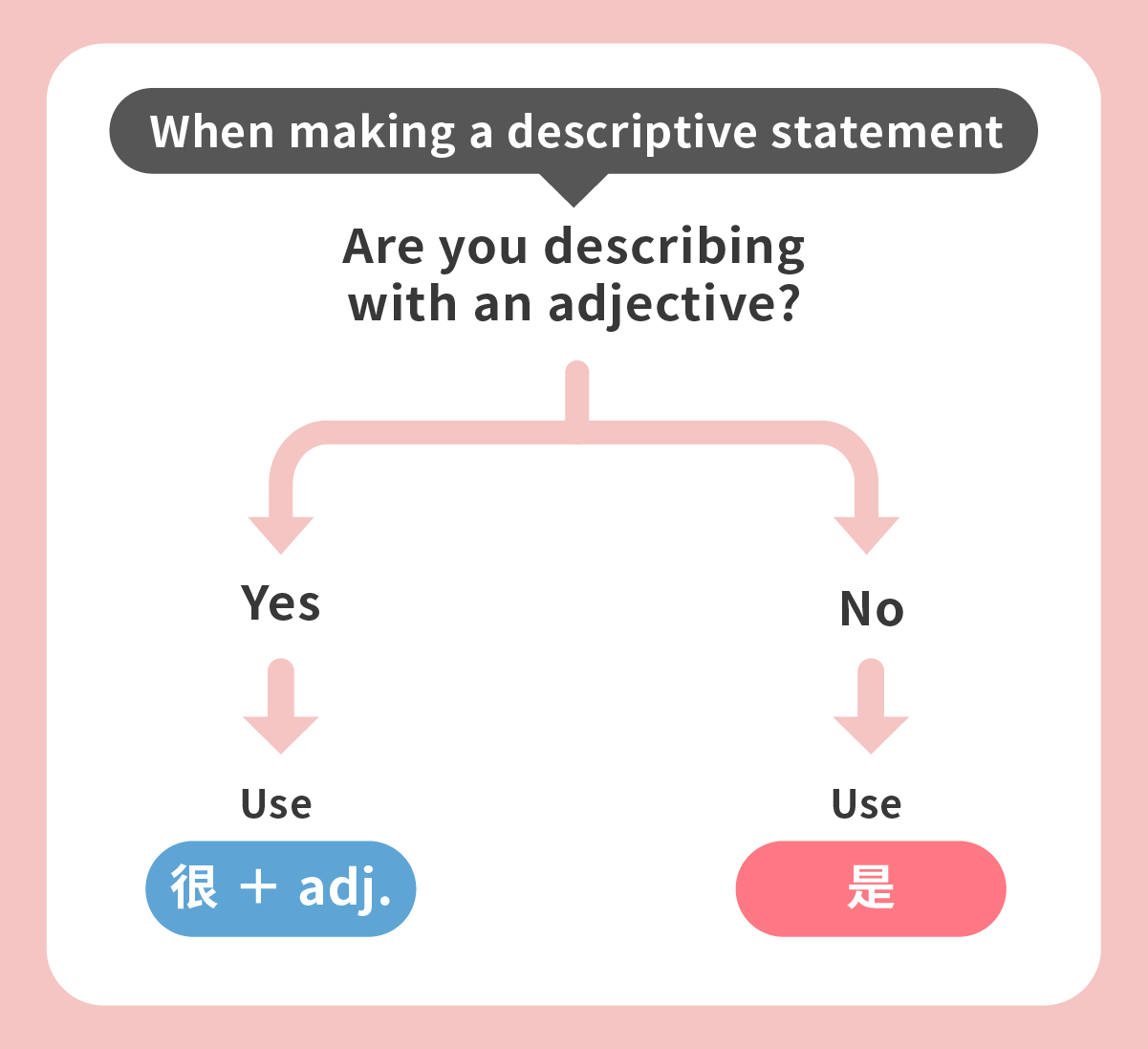
Incorrect:
- ❌ 他是高 = He is tall.
- ❌ 她是漂亮 = She is pretty.
Correct:
- ✅ 他很高 = He is tall
- ✅ 她很漂亮 = She is pretty
In Mandarin, adjectives can function as verbs in themselves. But to make a natural-sounding descriptive sentence, we usually add 很 (hěn, “very”) as a neutral linking word—not necessarily meaning “very.”
Why not just say “他高”?
- You can, but it sounds abrupt or comparative, as if you're saying "he is taller (than someone else)."
- Adding 很 smooths the sentence and avoids this implication.
Quick Wrap-up: Take this thought process into consideration if you feel confused among 有、是 and 很 +adj.

Time for some exercise!
1. Which of the following is the most natural in casual, spoken Mandarin?
A. 我的爸爸今天不在家。
B. 我爸爸今天不在家。
C. 我是爸爸今天不在家。
→ Answer: B
2. Which of the following sentences is not appropriate if the original sentence is omitting 的?
A. 學校圖書館門口的雨傘。
B. 美國的手機很貴。
C. 他的哥哥很帥。
→ Answer: A
3. Which sentence is grammatically correct?
A. 他是誰嗎?
B. 他是學生嗎?
C. 你是老師呢?
→ Answer: B
4. Which sentence should you use if you are trying to ask someone: “Are you hungry?”
A. 你是餓嗎?
B. 你是餓呢?
C. 你很餓嗎?
D. 你很餓呢?
→ Answer: C
5. What particle should you use?
Jane: 你喜歡什麼運動?
Brett: 我喜歡打籃球,你 ___?
→ Answer: 呢
6. Which sentence is correct?
A. 我家門前很小河。
B. 我家門前是小河。
C. 我家門前有小河。
→ Answer: C
7. Fill in the blank:
那裡____很多狗。 (There are a lot of dogs.)
→ Answer: 有
8. Choose the correct sentence for “He is a student.”
A. 他有學生。
B. 他是學生。
C. 他很學生。
→ Answer: B
9. Choose the correct sentence for “She is adorable.”
A. 她有可愛。
B. 她是可愛。
C. 她很可愛。
→ Answer: C
10. Fill in the blank:
這個地方____漂亮。(This place is beautiful.)
→ Answer: 很



